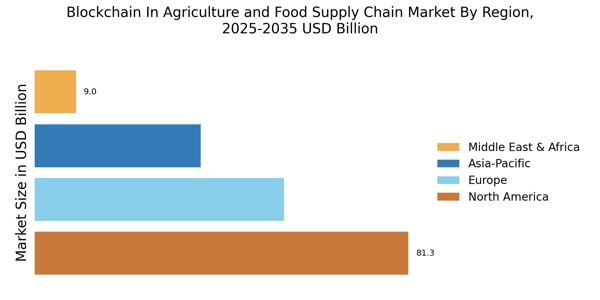Cost Efficiency
Cost efficiency is a pivotal driver in the Blockchain In Agriculture and Food Supply Chain Market. By streamlining processes and reducing intermediaries, blockchain technology can lower operational costs for producers and distributors. The automation of record-keeping and transaction verification minimizes the need for manual oversight, which can be both time-consuming and error-prone. A study indicates that companies utilizing blockchain can achieve cost reductions of up to 30% in supply chain management. This potential for significant savings is likely to attract more stakeholders to adopt blockchain solutions, thereby enhancing the overall efficiency of the agriculture and food supply chain.
Enhanced Transparency
The Blockchain In Agriculture and Food Supply Chain Market is witnessing a growing demand for transparency among consumers and stakeholders. This trend is driven by the increasing awareness of food safety and quality issues. Blockchain technology enables the secure and immutable recording of transactions, which allows for real-time tracking of products from farm to table. As a result, consumers can verify the origin and quality of their food, fostering trust in the supply chain. According to recent data, approximately 70% of consumers express a preference for brands that provide transparent sourcing information. This heightened demand for transparency is likely to propel the adoption of blockchain solutions in the agriculture and food supply chain sector.
Regulatory Compliance
Regulatory compliance is becoming increasingly critical in the Blockchain In Agriculture and Food Supply Chain Market. Governments and regulatory bodies are implementing stringent food safety regulations to ensure consumer protection. Blockchain technology offers a robust solution for compliance by providing an auditable and tamper-proof record of transactions. This capability allows companies to demonstrate adherence to safety standards and traceability requirements efficiently. For instance, the implementation of blockchain can reduce the time required for audits and inspections, potentially decreasing costs associated with compliance. As regulations continue to evolve, the demand for blockchain solutions that facilitate compliance is expected to rise significantly.
Consumer Demand for Sustainability
The rising consumer demand for sustainable practices is a notable driver in the Blockchain In Agriculture and Food Supply Chain Market. As consumers become more environmentally conscious, they seek products that align with their values. Blockchain technology can facilitate the tracking of sustainable practices throughout the supply chain, providing consumers with verifiable information about the environmental impact of their food choices. This capability not only enhances brand loyalty but also encourages producers to adopt more sustainable practices. Reports suggest that nearly 60% of consumers are willing to pay a premium for sustainably sourced products, indicating a strong market potential for blockchain solutions that promote sustainability.
Innovation in Agricultural Practices
Innovation in agricultural practices is significantly influencing the Blockchain In Agriculture and Food Supply Chain Market. The integration of blockchain with emerging technologies such as IoT and AI is creating new opportunities for efficiency and productivity. These innovations enable farmers to monitor crop health, optimize resource usage, and enhance yield predictions. Blockchain serves as a secure platform for sharing data among stakeholders, facilitating better decision-making and collaboration. As the agriculture sector continues to evolve, the adoption of blockchain technology is likely to accelerate, driven by the need for innovative solutions that address modern agricultural challenges.



















Leave a Comment